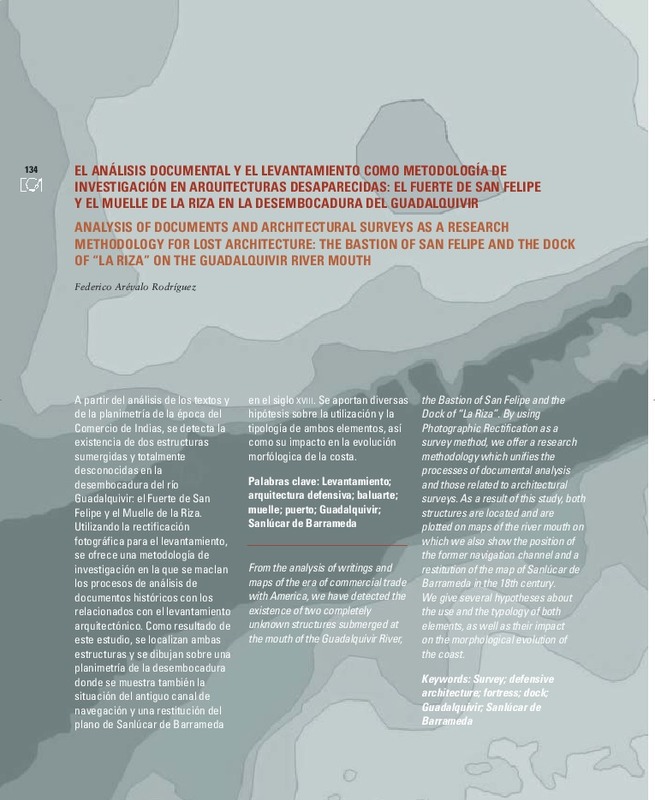JavaScript is disabled for your browser. Some features of this site may not work without it.
Buscar en RiuNet
Listar
Mi cuenta
Estadísticas
Ayuda RiuNet
Admin. UPV
EL ANÁLISIS DOCUMENTAL Y EL LEVANTAMIENTO COMO METODOLOGÍA DE INVESTIGACIÓN EN ARQUITECTURAS DESAPARECIDAS: EL FUERTE DE SAN FELIPE Y EL MUELLE DE LA RIZA EN LA DESEMBOCADURA DEL GUADALQUIVIR
Mostrar el registro sencillo del ítem
Ficheros en el ítem
| dc.contributor.author | Arévalo Rodríguez, Federico
|
es_ES |
| dc.date.accessioned | 2013-03-01T08:02:52Z | |
| dc.date.available | 2013-10-23T22:30:51Z | |
| dc.date.issued | 2012 | |
| dc.identifier.issn | 1133-6137 | |
| dc.identifier.uri | http://hdl.handle.net/10251/27408 | |
| dc.description.abstract | [EN] From the analysis of writings and maps of the era of commercial trade with America, we have detected the existence of two completely unknown structures submerged at the mouth of the Guadalquivir River, the Bastion of San Felipe and the Dock of ¿La Riza¿. By using Photographic Rectification as a survey method, we offer a research methodology which unifies the processes of documental analysis and those related to architectural surveys. As a result of this study, both structures are located and are plotted on maps of the river mouth on which we also show the position of the former navigation channel and a restitution of the map of Sanlúcar de Barrameda in the 18th century. We give several hypotheses about the use and the typology of both elements, as well as their impact on the morphological evolution of the coast. | es_ES |
| dc.description.abstract | [ES] A partir del análisis de los textos y de la planimetría de la época del Comercio de Indias, se detecta la existencia de dos estructuras sumergidas y totalmente desconocidas en la desembocadura del río Guadalquivir: el Fuerte de San Felipe y el Muelle de la Riza. Utilizando la rectificación fotográfica para el levantamiento, se ofrece una metodología de investigación en la que se maclan los procesos de análisis de documentos históricos con los relacionados con el levantamiento arquitectónico. Como resultado de este estudio, se localizan ambas estructuras y se dibujan sobre una planimetría de la desembocadura donde se muestra también la situación del antiguo canal de navegación y una restitución del plano de Sanlúcar de Barrameda en el siglo XVIII. Se aportan diversas hipótesis sobre la utilización y la tipología de ambos elementos, así como su impacto en la evolución morfológica de la costa. | es_ES |
| dc.language | Español | es_ES |
| dc.language | Inglés | |
| dc.publisher | Editorial Universitat Politècnica de València | es_ES |
| dc.relation.ispartof | EGA. Revista de Expresión Gráfica Arquitectónica | |
| dc.rights | Reserva de todos los derechos | es_ES |
| dc.subject | Levantamiento | es_ES |
| dc.subject | Arquitectura defensiva | es_ES |
| dc.subject | Baluarte | es_ES |
| dc.subject | Muelle | es_ES |
| dc.subject | Puerto | es_ES |
| dc.subject | Guadalquivir | es_ES |
| dc.subject | Sanlúcar de barrameda | es_ES |
| dc.subject | Survey | es_ES |
| dc.subject | Fortress | es_ES |
| dc.subject | Dock | es_ES |
| dc.subject | Defensive architecture | es_ES |
| dc.title | EL ANÁLISIS DOCUMENTAL Y EL LEVANTAMIENTO COMO METODOLOGÍA DE INVESTIGACIÓN EN ARQUITECTURAS DESAPARECIDAS: EL FUERTE DE SAN FELIPE Y EL MUELLE DE LA RIZA EN LA DESEMBOCADURA DEL GUADALQUIVIR | es_ES |
| dc.title.alternative | ANALYSIS OF DOCUMENTS AND ARCHITECTURAL SURVEYS AS A RESEARCH METHODOLOGY FOR LOST ARCHITECTURE: THE BASTION OF SAN FELIPE AND THE DOCK OF ¿LA RIZA¿ ON THE GUADALQUIVIR RIVER MOUTH | es_ES |
| dc.type | Artículo | es_ES |
| dc.date.updated | 2013-02-15T13:01:25Z | |
| dc.identifier.doi | 10.4995/ega.2012.1411 | |
| dc.rights.accessRights | Abierto | es_ES |
| dc.description.bibliographicCitation | Arévalo Rodríguez, F. (2012). EL ANÁLISIS DOCUMENTAL Y EL LEVANTAMIENTO COMO METODOLOGÍA DE INVESTIGACIÓN EN ARQUITECTURAS DESAPARECIDAS: EL FUERTE DE SAN FELIPE Y EL MUELLE DE LA RIZA EN LA DESEMBOCADURA DEL GUADALQUIVIR. EGA. Revista de Expresión Gráfica Arquitectónica. 17(20). https://doi.org/10.4995/ega.2012.1411 | es_ES |
| dc.description.accrualMethod | SWORD | es_ES |
| dc.relation.publisherversion | https://doi.org/10.4995/ega.2012.1411 | es_ES |
| dc.description.upvformatpinicio | 134 | |
| dc.description.upvformatpinicio | 143 | |
| dc.description.volume | 17 | |
| dc.description.issue | 20 | |
| dc.identifier.eissn | 2254-6103 | |
| dc.description.references | VV.AA., 1986. Ciudades del Siglo de Oro. Las vistas espa-olas de Anton Van den Wyngaerde. Madrid, Ediciones El Viso, pp 323- 326. | es_ES |








